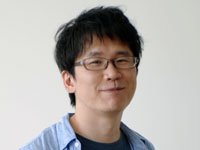Sep. 24, 2021
Stress and stability in cells and tissues
Sa Kan Yoo, Team Leader / Chief Scientist

Please briefly describe your current research.
My team is interested in how cells, tissues and organisms respond to stresses and maintain their homeostasis. Maintenance of homeostasis is a very dynamic process, and there are still many things we don’t understand, but it could reveal the fundamental mechanisms behind how our body is maintained at the molecular, cellular and tissue levels.
How did you become interested in your current field of research?
I’ve been interested in stress responses since I was a kid. For example, I was interested in why we can heal a small wound, but not a big one. I wanted to know why and how animals can and cannot repair tissues. More specifically, I’ve always been interested in regenerative medicine. But when I was a medical student, I noticed that many people were already working on human regenerative medicine so I felt there was not much for me to do. I decided to use more unusual animals such as zebrafish and fruit flies to study tissue repair mechanisms. While pursuing tissue repair mechanisms, I felt that we need to understand how tissues are maintained in normal conditions too. So that’s how I got into the fields of homeostasis and stress responses.

What do you think has been the most interesting discovery in your field recently?
In 2006, two groups in the US demonstrated that tissue stem cells exist in the fruit fly gut. That was a huge finding because before that no one expected that tissue stem cells would exist in the fly gut. After the papers were published, research on the intestinal stem cells of the fruit fly exploded.
How and when did you join RIKEN?
I originally joined RIKEN as an associate chief scientist in the summer of 2015 and became a chief scientist in 2017. In 2018, I also started a team at the RIKEN Center for Biosystems Dynamics Research .
What are some of the technologies that you use to conduct your research?
We combine classic Drosophila genetics and modern techniques such as confocal imaging, RNA-seq, whole-genome sequencing, metabolomics and proteomics.
How do you balance family life with your work at RIKEN?
I’m not a big fan of ‘work–life balance’ stuff. I never felt doing research was work, and still don’t. Maybe my current mentality is the same as when I was a student: doing research has always been like ‘play’. So for me ‘play–chore balance’ sounds like a more reasonable phrase. Chores are the things I need to do, but don’t feel like doing, such as administrative paper work… Personally, I easily intersperse my research activities and family life and I think of both as mainly ‘play’.
